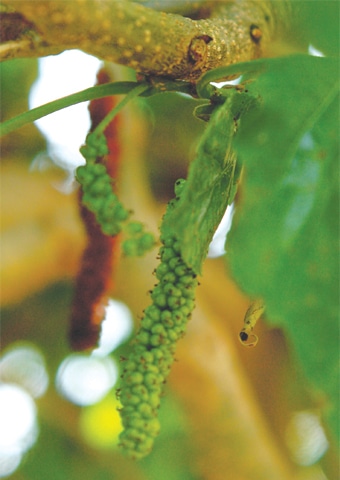
Q. Which grape variety is most suitable for the Peshawar climate?
A. Just last year, the Pakistan Agricultural Council concluded in-depth research on this subject. Their findings place King’s ruby at the top of the list for the agro-climate of Peshawar. King’s ruby is a seedless, early maturing grape which doesn’t split as rapidly as some other varieties. If a green/white grape is your preference, then another seedless variety, Abasin-2000, also performed exceptionally well in field trials.
Q. If I grow Sundar khani grapes in Peshawar will it bear fruit?
All your gardening queries answered
A. It should if correctly cared for but do keep in mind that Sundar khani grape is primarily grown for drying into sultanas rather than for the table. If it is a table grape you want, please refer to the answer to the previous question.
Q. When is the best time to re-pot a pot-grown tree?
A. During winter when it is dormant or, in the case of an evergreen, relatively dormant, and certainly before new growth begins to appear in early spring is also good time.
Q. I have about 30 coconut palms in my Darussalam Society, Karachi garden. The trees are planted about 12 feet apart, get plenty of water and sun and the soil is very good and salt free. The problem is that approximately 80 percent of the coconuts dry out when just one to two inches in size. Kindly advise a remedy.
A. A coconut palm does not carry all of its ‘buttons’ — as very tiny coconuts are called — through to maturity but shedding 80 percent is a high percentage to lose. Since you are certain that the palms are well-irrigated, and as long as they are not water-logged, I would suggest that the problem is that of nutrition. A mature coconut palm needs approx 20 to 25kgs of organic compost each year: this can be divided into half and applied as surface mulch, around but not touching the trunk, at six-monthly intervals (twice a year). In addition to this, 2kg pure wood-ash — ash made by burning fallen palm fronds and other, disease free, coconut palm waste is ideal — along with 0.5kg common salt, should be given to each tree immediately before the onset of the summer monsoon. Salt is essential for the health of the coconut palm. If none of this, please check for insect or fungal infestation and get back to me.

Q. Can avocados be successfully grown in Lahore?
A. Yes they can, but do try to locate saplings of frost hardy varieties — such as ‘Avocado Mexicana’ — as tropical/sub-tropical avocado trees dislike even the slightest touch of frost. It is also recommended that you grow two to three trees for cross-pollination and heavy crop production.
Q. My Pongamia pinnata tree — Sukh chan — is not growing. Should I give it urea to help it grow properly and fast?
A. It is quite natural for Sukh chan to grow extremely slowly — if at all — through winter months but, now that spring is here, it should begin to put on new growth as long as it is regularly irrigated without being allowed to get water-logged. It is not necessary to feed it with anything at this point although, if you are still concerned, apply liquid organic fertiliser as per instructions on the bottle.
Q. Where can I get an olive tree from?

A. Try your local nursery although, this being spring, you may now have to wait until next winter.
Q. Can Safarjal fruit be grown in Karachi and where can I buy seeds of mulberry for silk worms?
A. Cydonia oblonga (Quince) or Safarjal is not suitable for cultivation in Karachi as winter there is neither cold enough nor long enough to supply the rest it needs: without this winter rest, the tree/shrub will not flower and, even if it did, hot/humid weather fungal infections would harm it in summer.

Morus alba (white mulberry) is generally grown from saplings, brought to Karachi in winter from either Punjab or Balochistan, rather than from seed.
Q. What is the best time for repotting cacti and succulents in Larkana?
A. Any time of year, as long as the plants are not developing flower-buds or are in bloom. Personally speaking, I find that late spring to mid-summer is an exceptionally successful transplanting period for cacti and succulents and for potting up their cuttings/off-sets as the heat and humidity seem to help them along.
Please continue sending your gardening queries to zahrahnasir@hotmail.com. Remember to include your location. The writer does not respond directly by email. Emails with attachments will not be opened.
Published in Dawn, EOS, April 29th, 2018














































